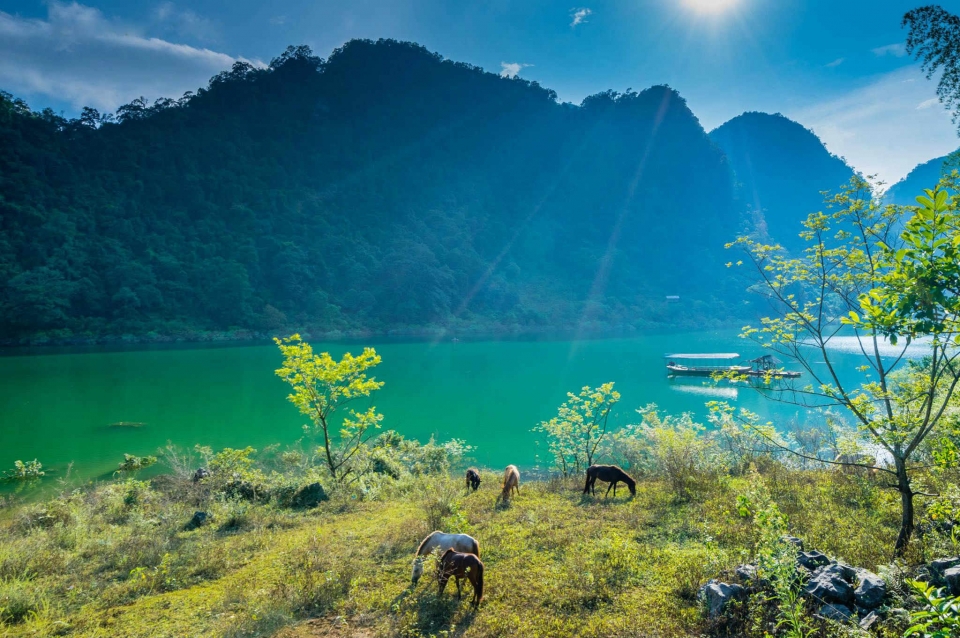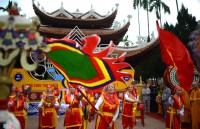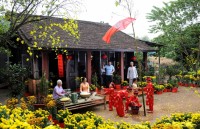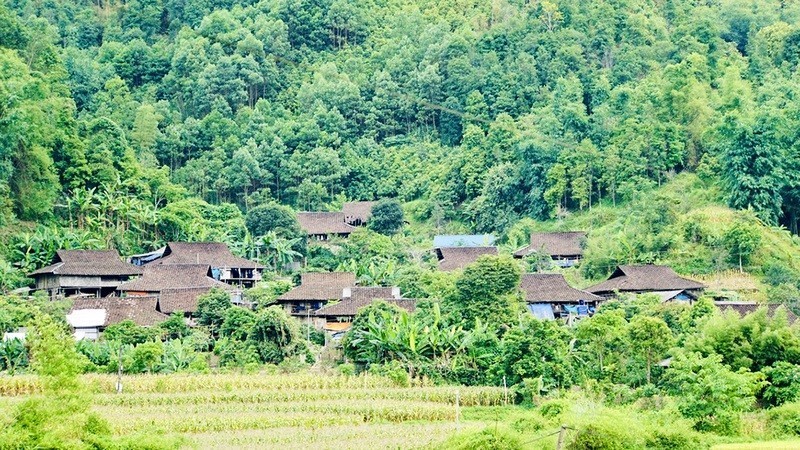
A visit to Three-Basin Lake - Hồ Ba Bể
Latest
| TIN LIÊN QUAN | |
| Here comes Tết, the Lunar New Year | |
| My village | |
While climbing on the island, my companion, stage director Đình Quang, was struck by the sight of trees spouting out of naked rocks, their knotty roots clambering all over like so many snakes. He muses aloud on the eternity of nature and the evanescence of human life while the deputy chief of the Ba Bể District cultural service, himself a member of the Tày ethnic minority, relates to us a Tày legend on the origin of Pò Già Mải.
 |
| Ba Be Lake. (Photo: gsv.com.vn) |
Long, long ago, the local population held a festival to celebrate the glory of Buddha. An old leper woman took pity on her, gave her something to eat and a place to stay. The beggar woman, who turned out to be a snake-goddess in disguise, said to her, “You have a good heart. Tomorrow, a flood will drown the village together with all its inhabitants. Seek refuge on a hillock, and you will be saved. Take this rice grain, break it in two, and you will have a canoe to move on water.” It all happened as the goddess had said. The hillock is now the islet Pò Già Mải (The Widow Hillock in Tày language).
The Dao minority also have a version of this legend, a variant on the first. A young thug in the village steals a bull of the pagoda and, slaughtering it, distributes the meat. Noticing the loss of the bull, Buddha sends an emissary to make inquiries. All of the villagers deny having eaten the beef, except for an old widow who brings her share as proof, along with a piece of the hide and the tail of the slaughtered bull. The emissary tells her to sow the ash around her house on the hillock, and a deluge drowns everyone in the village, sparing only her house.
The Pò Già Mải islet is one of the jewels of the Ba Bể National Park, or “Tonkin Park” at the time of the French colonization.
Ba Bể Lake lies in Ba Bể District (Chợ Rã), Bắc Cạn province, 223 km from Hà Nội through the towns of Thái Nguyên and Bắc Cạn. From Chợ Rã, a motorboat will take you to an area of picturesque mountains and forests, dotted with grottoes, pierced with tunnels, furrowed by deep valleys and the basin of the Ba Bể Lake, and peopled with several ethnic groups.
The Ba Bể Lake covers 500 ha, and is 8 km long, 3 km wide and 20-40 m deep.
Such an abundant body of water in such a dry region is a geographical rarity. Two million years ago, violent geographical jolts would have created Ba Bể, breaking mountains into pieces, and creating the unique heaps of piled-up rocks such as are seen at Pò Già Mải. The Ba Bể National Park is covered with primeval forests harboring numerous precious wood trees, 111 species of birds, 18 species of reptiles, 100 species of butterflies, and 38 species of mammals. including 9 very rare ones.
Ba Bể - Ba (three) Pé in the Tày language (Pe means water hole, lake, or bay) is made up of three Pé: Pé Lầm, Pé Lù and Pé Lìng. Visiting Pe Lầm one can see the Fairy Pond, a small pool of limpid water on a mountain-top, believed to be a fairy meeting ground. South of Pé Lầm is An Mã (Sealed Horse) island, where a joyous spring festival takes place every year from the 5th to the 7th day of the new year on the lunar calendar, celebrating with canoe races, bull fighting, wrestling, and ball games. Going down Năng river we can visit several interesting sites, particularly the Đầu Đẳng waterfall and the Puông tunnel. The Đầu Đẳng fall on the border between Bắc Cạn and Tuyên Quang provinces sends masses of water down into the Năng river with extreme violence through layers of rock 7-8 meters high, a must-see on a visit to this area of legendary natural beauty.
Huu Ngoc
 | A toast to Vietnamese rice wine It is traditional in Viet Nam that women do not drink alcohol as it is considered to be a man’s domain. One Sino-Vietnamese proverb claims: ... |
 | The month of festivities An old Vietnamese folk song reads: "The first month is given to Tết at home, the second to gambling, the third to festivities, etc." (The ... |
 | Tet and the Vietnamese cultural identity "I have never seen in the world a festival as popular as the Vietnamese Tet and with a more humanistic character," writes culturologist Huu Ngoc. |

















